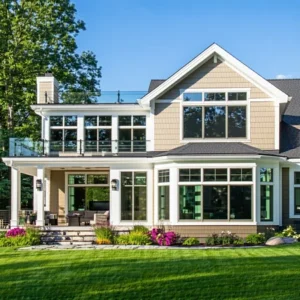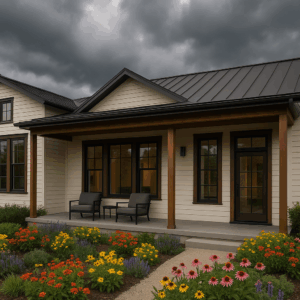Algae on your roof may not seem like a big deal, but it can actually lead to major issues if left untreated. Not only can it make your roof look dirty and just plain unattractive, but it can also cause damage to shingles and shorten the life of your roof. In this blog post, I’ll be taking you through the most common causes of algae growth on roofs in Maryland and Virginia and provide you with some tips and tricks for getting rid of it. I’ll also be offering my best advice for preventing algae from coming back, so you can enjoy a clean, healthy roof for years to come.
What Causes Algae Growth on Roofs?
Algae growth on roofs is a common problem for many homeowners. There are several factors that can contribute to the growth of algae, such as humidity, shade, and location. For example, roofs that receive a lot of shade or are located in humid climates are more likely to experience algae growth. While Maryland and Virginia experience quite mild weather year-round, our region frequently experiences high humidity levels.
Roofs made of certain materials, such as asphalt shingles, are more susceptible to algae growth than others. The warm and humid environment on the shingles provides the perfect breeding ground for algae. The algae spores can be easily transported by wind and can thrive on your roof surface, especially when conditions are damp.
Why Algae Can Be a Big Problem for Your Roof
Algae growth on your roof may seem like just a cosmetic issue, but it can actually lead to major problems if left untreated – like damage to your shingles. The algae on your roof can hold moisture against the shingles, which can cause the shingles to degrade and shorten the life of your roof. Not to mention algae can eat away at the granules on your shingles, which can make them more susceptible to leaks and other types of damage.
Algae growth can also provide an environment for moss and lichen to grow, which can also cause some damage to your shingles. This can be a serious problem, especially in places where the shingles provide insulation and waterproofing to the structure. That’s why it’s essential to address the issue of algae growth on your roof, not only to maintain the appearance of your home but also to protect the integrity and longevity of your roof.
How to Get Rid of Algae on Your Roof
Noticing a build-up of algae? Don’t stress just yet – here are some of my tips to getting rid of algae on your roof.
-Identify the type of algae you have on your roof: Algae can be identified by its color, which can range from green, black, or blue. This will help you choose the right cleaning solution for your roof.
-Clean the roof: A solution of water and bleach can be used to clean the roof. You can use a garden sprayer or a pressure washer to apply the solution. It is important to note that when cleaning with a pressure washer, you should use a nozzle with a wide fan pattern and keep the nozzle at a safe distance from the roof to avoid damaging the shingle.
-Scrub the roof: After cleaning, it’s important to scrub the roof to remove any remaining algae. You can use a stiff-bristle brush or a roofing brush to scrub the roof. Be sure to scrub gently to avoid damaging the shingles.
-Rinse the roof: Once you’ve scrubbed the roof, rinse it off to remove any remaining cleaning solution.
While the above can be a DIY job, it’s a smart idea to use a professional company or to hire a professional roofer to handle this task; it can be risky business getting up on your roof, especially if your roof is in a bad state. Professionals are equipped with the proper tools and techniques to safely remove algae from your roof, and while they’re up there, can also offer advice or let you know if you have any underlying issues with your roof.
Tips to Prevent Algae from Returning
Want to stop algae from returning? Try some of these handy tips to stop algae in its tracks:
-Install a zinc or copper strip at the peak of your roof: The metals in zinc and copper can stop the growth of algae on your roof. As rainwater runs over the strips, it will release the metals, which will then flow down your roof and act as a natural algaecide.
-Trim nearby trees and plants: Overhanging branches and plants can provide shade and retain moisture on your roof, which can contribute to the growth of algae. Trimming nearby trees and plants can help increase sunlight exposure and airflow on your roof.
-Install reflective roofing materials: Light-colored reflective roofing materials can help keep your roof cool and lessen the amount of moisture that accumulates on your roof, which can inhibit the growth of algae.
At the end of the day, regularly inspecting and maintaining your roof is the best way to prevent algae from returning as you can nip it in the bud as soon as you see the first signs of an algae problem. You can also schedule a professional roof clean every year or so to remove any algae or moss before they have a chance to take root.
What Should You Do if Algae Has Already Damaged Your Roof?
If algae has already damaged your roof, it’s important to take action as soon as possible to address the issue. Here are a few steps you should take:
-Inspect the damage: It’s really important to identify the extent of the damage. You can do this by inspecting the roof yourself or hiring a professional roofing inspector to evaluate the condition of your roof.
-Make repairs: Depending on the extent of the damage, you may need to make repairs to your roof. This could include patching leaks, replacing missing shingles, or installing new flashing.
-Clean the roof: Once you’ve repaired any damage, it’s important to clean the roof to remove any remaining algae. You can use a solution of water and bleach, or a specialized roof cleaning solution, to clean the roof.
-Consider getting a new roof: If your roof is old, or too damaged it might be time to consider getting a new roof. It can be a big investment, but it can be worth it in the long run to protect the structural integrity of your home and avoid future leaks and damages.
Get a Professional Opinion
As you can see, algae growth on your roof can cause some serious problems if you don’t take care of it. Not only does it make your roof look dirty, but it can also damage your shingles, shorten the life of your roof and even create a breeding ground for moss and lichen. It’s important to nip it in the bud as soon as possible – not just for the looks of your house – but also to make sure your roof lasts.
If algae’s gotten ahold of your roof beyond a DIY repair and you need professional help, get in touch with the WoW team today. Whether you need help replacing a few shingles, repairing leaks or an entire roof replacement, we can help make the process hassle-free. Get in touch today.



